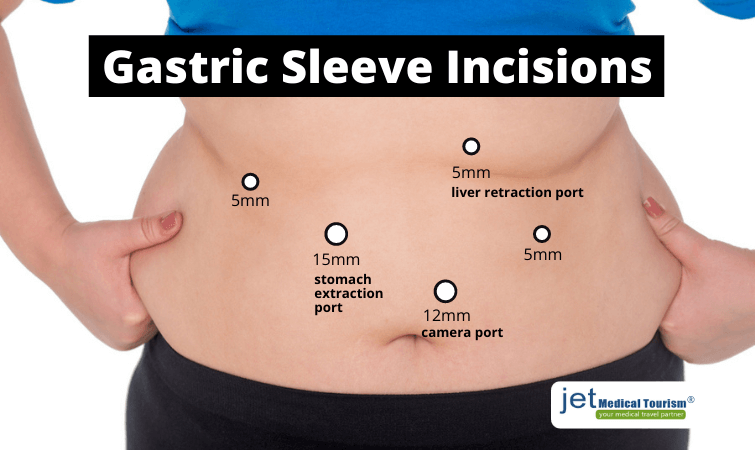Gastric Sleeve Incisions, Illustrations
Gastric sleeve incisions are a critical area of concern for patients who are planning to undergo a sleeve gastrectomy. The idea that the bariatric surgery will involve a significant cut across the abdomen to remove a portion of the stomach can naturally cause a worry. Patients wonder whether bariatric surgery incision pain will be severe, how long will the incision site take to heal, and how many incisions for gastric sleeve may be required.
At the time of your pre-operative consultation, you should discuss all these issues related to gastric sleeve incisions with your weight loss surgeon. A dedicated surgeon will take the time to address all your concerns accurately and in detail. They may present before and after photos, diagrams, graphics, or gastric sleeve illustrations to explain to you how the incisions will be created, where they will be placed, and how long it will take to heal.
Gastric sleeve incisions
Gastric sleeve incisions refer to the surgical cuts that are made at the time of your sleeve gastrectomy procedure to access the inner anatomy of the abdomen. In most cases, the surgeon will create multiple small incisions to perform the procedure laparoscopically. However, in a few cases, a single incision gastric sleeve surgery may be performed.

Laparoscopic Sleeve Gastrectomy
Laparoscopic surgical technique is most advanced to perform this bariatric procedure. Although it will involve several incisions, they will be tiny in size. Your surgeon will introduce a small optic fiber video camera (laparscope) through the incisions to view the inner stomach structures on an external monitor outside.
Open Surgery and Single Incision Technique
In rare cases, an open traditional surgery may be performed, which will involve relatively larger gastric sleeve incisions. In all cases, the gastrectomy incision site will be marked in advance, and the patient will be informed about the potential post-surgical scarring. Single incision gastric sleeve Mexico is a special technique, which may be considered for some candidates.
Incision Healing and Recovery
Patients are often concerned about gastric sleeve incisions healing. At the time of your initial consultation, your surgeon will discuss with you the estimated recovery time, depending on the customized surgical plan. In general, the recovery will be faster in case of a laparoscopic surgery, while the open surgery takes more time to heal.
How many incisions for gastric sleeve

One of the common questions patients want to ask their surgeon is how many incisions for gastric sleeve will be required. If the procedure is performed laparoscopically, it will usually involve a total of five small incisions. Three incisions will be only about quarter of an inch in length, while one incision will be about half an inch in length.
A fifth incision may be placed in some cases, which will be less than three-fourth of an inch. In a single incision gastric sleeve surgery, as the name suggests, only one small incision will be placed. The open traditional surgery, which is rarely performed nowadays, may involve multiple incisions, depending on the specific surgical plan.
Where are the incisions for gastric sleeve?
At the time of your initial consultation, your gastric sleeve surgeon will review your BMI, body size, abdominal anatomy, and general health condition. They will use these parameters to determine an incision placement that is tailored to meet your unique needs. Your surgeon will also discuss your concerns about potential scarring, and make the incision plan appropriately.
Feel free to ask your surgeon about “where are the incisions for gastric sleeve” during your consultation.
Gastric sleeve incision sites
Gastric sleeve incision sites are primarily located in the upper abdomen. Your stomach is present in the left side of your upper abdomen, so the incisions may be located in that area of the abdominal wall. Remember that your abdomen is home to all the digestive organs, including the stomach, intestines, liver, pancreas, and gallbladder.
Precise Incision Placement is Vital
Your bariatric surgeon must have a thorough understanding of the underlying abdominal anatomy in order to place the incisions in precise locations. The goal is to perform your weight loss surgery in the least invasive way possible. Therefore, where the gastric sleeve incision sites are located will play a key role.
Discreet Sites will Reduce Scarring
In a single incision gastric sleeve surgery, the incision site is located around the navel (belly button) area. In rare cases, when a traditional open surgery is performed, the incisions may be longer across the abdomen. A skillful surgeon will be able to place the incisions in discreet locations, such as natural abdominal folds and creases to minimize subsequent scarring.
Gastric sleeve illustrations
Sometimes it can be difficult for patients to understand the incision placement through verbal explanation. If you are concerned about where are the incisions for gastric sleeve, and how visible will be the subsequent scars, you should request your surgeon to provide you pictures, diagrams, graphics, or a video.
A resourceful and experienced surgeon will be able to present before you accurate gastric sleeve illustrations during your initial consultation. These sketches or diagrams will have the gastric sleeve incision sites clearly marked on them. You can ask your surgeon about the estimated length of each incision, and the surgical purpose of the incision.
Gastric sleeve illustrations are an excellent way to understand where exactly your incisions will be placed. You will get a fair idea of what kind scarring you may experience after the surgery. Some surgeons may also be able to provide you online gastric sleeve pictures and illustrations, which you can review any time in your own smartphone or laptop.
Gastric sleeve incision pain
Pain is always a major concern for a patient in any surgical procedure. The good news is that you will feel no VSG incision pain at the time of the surgery. You will be placed under general anesthesia before your gastric sleeve surgery begins. You will be in deep sleep through your procedure, and will have no feeling or recollection of the surgery when you wake up.
Minimal Post-Op Discomfort
Gastric sleeve incision pain or discomfort will be minimal after your surgery, if the procedure is performed laparoscopically or using a single incision technique. In any case, your surgeon will prescribe mild pain medications for a few days to keep you comfortably during your initial post-op recovery phase.
YOU MIGHT ALSO LIKE: Gastric sleeve surgery post op diet
Protect Your Incisions
If you experience persistent or severe incision pain after gastric sleeve, you should consult with your surgeon for medical advice. This could be a sign of infection, which can be treated with antibiotics and other treatments. To avoid VSG incision pain, make sure to protect your incision sites from contamination or injury until the healing is complete.
Gastric sleeve incisions healing
Sleeve gastrectomy procedure is relatively less invasive when performed laparoscopically. Therefore, your gastric sleeve incisions healing will take place quite rapidly. For the first week, you should keep the incision sites covered with bandage or cloth to allow for safe healing. Avoid vigorous physical activities, bending or lifting of weights during this time.
From the second week, your gastric sleeve incisions healing should have progressed sufficiently to let you resume your normal routine. However, continue to avoid strenuous exercises for another four to six weeks. Within three months after your surgery, your incisions would have completely healed. It is best to avoid smoking during recovery to prevent delayed healing of your incisions.
RELATED READ: Should I stop smoking before bariatric surgery?
Gastric sleeve incisions itch: Good or bad?
Patients are sometimes concerned about the gastric sleeve incisions itch, which may occur a few days after your surgery. As the natural healing mechanism of your body is triggered after the surgery, the tissue repair process will begin. As the wound bed is healed, it may cause a minor itching. Do not scratch the scab formation that occurs at this stage. Gastric sleeve incisions itch is good, and it indicates that your body is healing well.
Tips for Gastric sleeve Incisions Healing and Aftercare
Post-operative care is crucial to ensure proper healing of the incisions. Here are some general guidelines:
- Keep the Incisions Clean and Dry: Your surgeon will provide instructions on how to care for your incisions. Typically, you should avoid soaking them in water (e.g., no baths or swimming) until they are fully healed.
- Monitor for Signs of Infection: Redness, swelling, warmth, or discharge from the incision sites can be signs of infection. If you notice any of these symptoms, contact your healthcare provider immediately.
- Avoid Straining the Incisions: Heavy lifting or strenuous activities should be avoided for several weeks after surgery to prevent putting undue stress on the healing incisions.
- Use Scar Treatments: Once your incisions have closed and your surgeon gives the go-ahead, you may use scar creams, silicone sheets, or other treatments to help minimize scarring.
Gastric sleeve pics
When you are considering a weight loss surgery procedure, gastric sleeve pics can play a key role in helping you make a decision. These pictures belong to previous patients who have undergone the same procedure with successful results. Gastric sleeve photos usually include a set of pictures taken prior to the surgery and after the surgery at different stages of weight loss.
During your consultation with a bariatric surgeon, you should request them to present a few gastric sleeve pics. This will also help you form realistic expectations so that you can make an enlightened choice. Some surgeons maintain a comprehensive photo gallery of these pictures online or may share them on social media to educate patients about sleeve gastrectomy.
CHECK THIS OUT: Gastric sleeve before and after pictures
Gastric sleeve incision infected
Infection is one of the potential post-operative complications in almost any surgical procedure. If your gastric sleeve incision is infected, you should promptly contact your surgeon for corrective treatment. Signs of a gastric sleeve infection may include:
- The wound site is abnormally swollen or red
- Pus or foul-smelling fluid is oozing from the incision area
- You experience severe or persistent pain in the incisions
- You have recurring fever after your surgery
Gastric sleeve incision leaking
Some amount of gastric sleeve incision leaking is normal, which will clear the excess blood and fluid produced under the incision site. After your surgery is completed, your surgeon may place temporary drain tubes under the incision area to collect and remove this fluid. This fluid leakage will stop within a few days as the healing progresses. However, if the gastric sleeve incision leaking does not reduce or stop even after a week or 10 days, you should speak to your bariatric surgeon for advice.
RELATED POST: Signs and symptoms of gastric sleeve leak
Single incision gastric sleeve surgery
Recent advancements in bariatric surgery have led to the emergence of a few innovative incision techniques. One of the latest techniques is single incision gastric sleeve surgery. Only a few weight loss surgeons currently perform this procedure. This procedure is designed to be an improvisation on the popular laparoscopic gastric sleeve.
Unlike laparoscopic VSG, which involves multiple incisions, a single incision gastric sleeve surgery can be performed with just one small incision. The surgeon will place incision within the navel, through which a tiny camera will be inserted. The procedure minimizes the risk of sleeve complications and allows for a faster recovery with less discomfort.
Single incision gastric sleeve cost
Cost is an important factor to consider when you are planning to undergo a sleeve gastrectomy. Single incision gastric sleeve cost in Mexico will be in the range of $4,500 to $6,000 on average. But if you choose to have this surgery in the US or Canada, you may end up paying as much as $25,000 to $30,000 for the same procedure.
Your single incision gastric sleeve cost in Mexico will typically include the following cost components:
- Bariatric surgeon’s fee
- Fee of any other attending physicians and staff
- General anesthesia costs
- Surgery room costs
- Charges for one night stay at the hospital
- Nutritionist consultation
- Pre- and post-surgical tests
- Transportation to and from the airport
Single incision gastric sleeve Mexico
Some of the highly skilled and experienced bariatric surgeons now provide single incision gastric sleeve Mexico. Here are the procedure steps that will be a part of your surgery:
- General Anesthesia: Once you are in the surgery room, a qualified anesthesiologist will place you under general anesthesia.
- Incision Placement: Your weight loss surgeon will make a short incision in your navel area and insert a tiny video camera through it.
- Sleeve Surgery: Using advanced surgical instruments, the surgeon will remove about 80% of your stomach, while leaving a sleeve-shaped section.
- Incision Closure: Your newly formed stomach will be stapled, and the incisions will be closed with fine sutures.
Gastric sleeve scars
Any surgical procedure is bound to leave some scarring behind. However, skilled bariatric surgeons can adopt cutting-edge techniques to minimize your gastric sleeve scars. Laparoscopic sleeve gastrectomy (LSG) and single incision sleeve surgery are two less invasive and conservative techniques to perform this procedure.
With either of these procedures, you can expect minimal post-surgical gastric sleeve scars. An experienced surgeon will create the incisions in less conspicuous locations of your upper abdomen, such as the natural creases or folds. Any subsequent scars will be less visible in these locations. Talk to your surgeon about your customized surgical plan that takes scarring issues into account.
After your surgery, the gastric sleeve scarring may appear more pronounced at first. However, this is a normal occurrence, and as your healing progresses, the scarring will subside. In about one year, your VSG scars should fade into thin white lines. Your surgeon may recommend a cream or ointment to help reduce the gastric sleeve scar over time.
Gastric sleeve before and after scars
If you are particularly concerned about post-surgical scarring, you should request your surgeon to provide you with a few gastric sleeve before and after scars photos. This will give you a clear visual idea of how your sleeve gastrectomy scars may appear at different stages after the surgery. Gastric sleeve before and after scars images will eliminate the risk of any disappointment occurring at a later stage.
Risks of Gastric Sleeve Incisions
Gastric sleeve surgery, like any surgical procedure, carries certain risks, particularly related to the incisions made during the operation. Understanding these potential risks can help patients make informed decisions and take necessary precautions.
1. Infection: One of the most common risks associated with any surgery is the possibility of infection at the incision sites. If bacteria enter the body through these openings, it can lead to redness, swelling, pain, or discharge. In severe cases, an infection may spread and require further medical intervention.
2. Bleeding: Although rare, there is a risk of excessive bleeding during or after surgery from the incision sites. This may occur due to improper wound closure or blood vessel injury, and it may require additional surgical procedures to control.
3. Scarring: The incisions made during gastric sleeve surgery can lead to visible scarring. While most scars fade over time, some individuals may develop keloids or hypertrophic scars, which are raised and more pronounced. Scarring can also cause discomfort or restrict movement if it forms adhesions internally.
Common Questions About Gastric Sleeve Incisions
How many incisions are required?
A common question is how many incisions are required for gastric sleeve surgery. Typically, laparoscopic surgery involves five small incisions, with three being only about a quarter-inch long, one about half an inch, and another less than three-fourths of an inch. In single-incision surgery, as the name suggests, only one small incision is made.
Where are the incisions located?
Gastric sleeve incision sites are primarily located in the upper abdomen. The stomach is on the left side of the upper abdomen, so incisions are usually made in that area. Surgeons carefully plan incision placement based on your body size, BMI, and abdominal anatomy to ensure minimal scarring and optimal healing.
Choose Jet Medical Tourism® for Single incision gastric sleeve
Gastric sleeve incisions are a vital issue and you should know all about your surgical incisions and potential scarring. At Jet Medical Tourism®, our caring and compassionate weight loss surgeons will understand your concerns, and help you make the right decisions. You will feel much more confident after talking to our surgeons.
We know how important this surgery is for you, and we will leave no stone unturned to ensure you get the best results. Our top bariatric surgeons in Mexico have the expertise to perform laparoscopic sleeve gastrectomy as well as single incision gastric sleeve. To learn more about your options, call us now to schedule a free surgical consultation.





